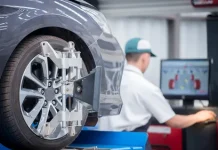Owning a recreational vehicle (RV) offers the freedom to explore, but like any vehicle, it requires upkeep—especially when it comes to safety-critical components like the windshield. RV windshield replacement is not just about aesthetics; it’s about maintaining visibility, structural integrity, and overall road safety. Whether you’re a full-time RVer or a weekend warrior, understanding the ins and outs of windshield replacement can save you time, money, and hassle down the road.
Why RV Windshields Are Unique
Unlike standard cars or trucks, RV windshields are often larger, curved, and sometimes split into two panels. This complexity means that RV windshield replacement requires specialized knowledge and equipment. These windshields are also designed to handle different stress factors due to the size and weight of the RV, making proper installation crucial.
Common Reasons for Replacement
Several factors can lead to the need for RV windshield replacement:
-
Road debris: Flying rocks or other objects can cause cracks or chips.
-
Weather damage: Extreme temperatures or hail can weaken or shatter the glass.
-
Stress cracks: Structural stress over time can lead to spontaneous cracking.
-
Aging seals: Over time, the rubber seals that hold the windshield in place can degrade, leading to leaks and reduced structural stability.
Signs You Need a Replacement
You may need to replace your RV’s windshield if you notice:
-
Cracks longer than six inches
-
Chips in the driver’s line of sight
-
Leaking during rain
-
Whistling sounds while driving
-
Loosening or shifting of the windshield
Delaying RV windshield replacement can worsen the damage and increase the risk of complete failure.
The Replacement Process
Replacing an RV windshield involves several key steps:
-
Assessment: A technician evaluates the extent of the damage and determines if replacement is necessary.
-
Removal: The old windshield is carefully removed to avoid damaging the frame or body.
-
Preparation: The area is cleaned, and any old adhesive is removed.
-
Installation: A new windshield is set into place using high-quality adhesives and seals.
-
Curing: The adhesive needs time to fully bond and cure, ensuring a secure fit.
-
Inspection: A final check ensures the windshield is properly aligned and sealed.
Cost Factors
The cost of RV windshield replacement varies depending on:
-
The make and model of the RV
-
Single-piece vs. dual-pane windshields
-
Labor rates in your area
-
Insurance coverage
Prices typically range from $1,000 to $5,000, though some insurance policies may cover the bulk of the expense.
Choosing the Right Service Provider
Given the specialized nature of the job, it’s essential to choose an experienced and reputable provider. Look for:
-
Certified glass technicians
-
Mobile replacement services
-
Warranty on parts and labor
-
Positive customer reviews
Some RV dealerships also offer in-house RV windshield replacement services with OEM (Original Equipment Manufacturer) parts.
Preventive Tips to Extend Windshield Life
While some damage is unavoidable, you can reduce the risk of needing a full RV windshield replacement by:
-
Keeping a safe distance from large vehicles
-
Avoiding roads with loose gravel or construction
-
Regularly inspecting for chips and addressing them promptly
-
Parking in shaded or covered areas to avoid sun stress
-
Ensuring wiper blades are clean and in good condition
Conclusion
Your RV’s windshield is more than just a window to the world—it’s a critical part of your vehicle’s structure and safety system. Knowing when and how to address RV windshield replacement can keep your journeys safe and uninterrupted. With the right care and attention, you can stay focused on the adventure ahead and not the glass in front of you.










